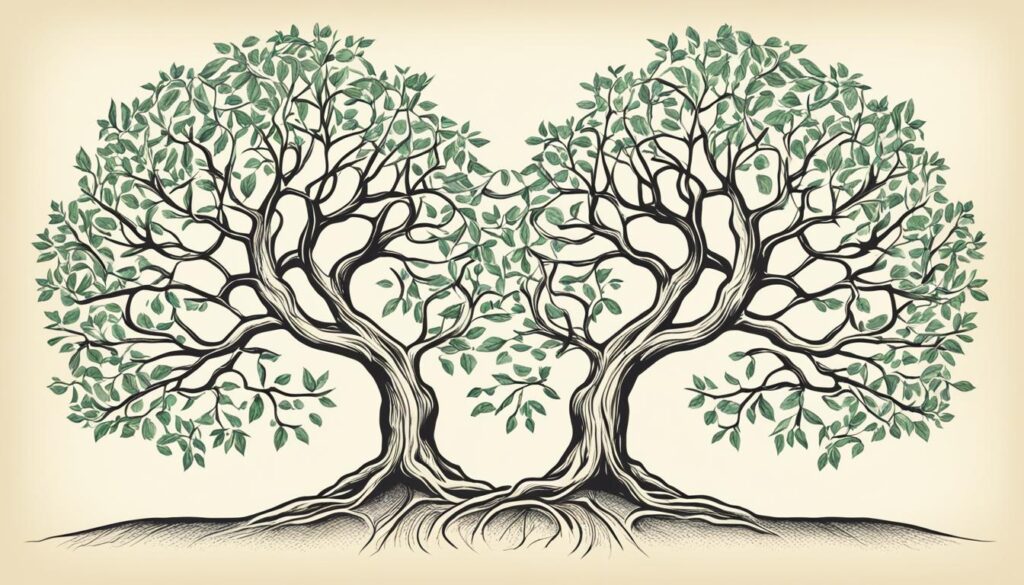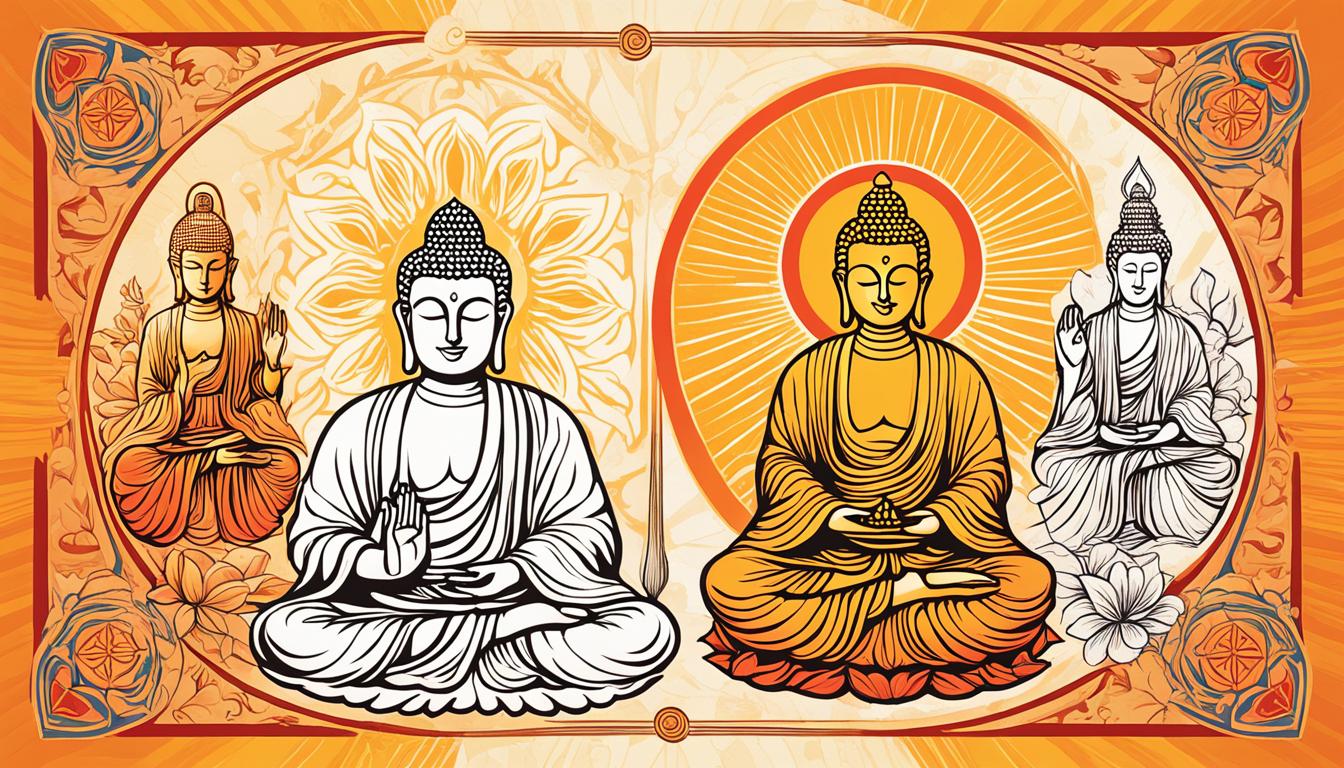Is it possible to find commonalities between two seemingly different spiritual traditions like Christianity and Buddhism? While they may appear to be worlds apart, these two major religions actually share more similarities than one might expect. Exploring the parallels between these belief systems can lead to a greater understanding of their connectedness and the shared values they hold.
Key Takeaways:
- Christianity and Buddhism, seemingly different, share remarkable similarities in teachings and values.
- Both religions emphasize finding inner peace, compassion, and personal transformation.
- Understanding the common ground between Christianity and Buddhism can foster unity and respect for diverse faiths.
- Exploring these similarities can challenge preconceived notions about the boundaries of religious traditions.
- Delving into the history and teachings of both Christianity and Buddhism sheds light on their shared quest to awaken humanity and bridge beliefs.
The Light Is Within Us
Both Buddha and Jesus emphasized the importance of looking within ourselves to find peace and love. Buddha taught that inner peace can be achieved through being still, practicing non-attachment, and radiating boundless love towards the world. Jesus also spoke about the inner light, describing believers as the light of the world and encouraging them to let their light shine before others. Both teachings highlight the inherent worth and capacity for love that exists within each individual, regardless of their faith.
When we explore the teachings of Buddha and Jesus, we discover profound similarities that transcend religious boundaries. Both spiritual leaders recognized the power of self-reflection, self-love, and compassion as transformative forces for inner peace and spiritual growth. Their teachings remind us that the answers we seek are not outside of ourselves, but reside deep within our own hearts and minds.
Like a flickering flame, the light within us can illuminate the path to finding inner peace and connecting with the divine. By turning inward and quieting our minds, we can experience a profound sense of stillness and clarity that transcends the chaos of the external world. In this stillness, we can cultivate self-love, acknowledging our inherent worthiness and embracing the divine spark within us.
Furthermore, both Buddha and Jesus emphasized the importance of extending love and compassion to others. Buddha taught the practice of Metta, or loving-kindness, which involves radiating boundless love and positive intentions towards all beings. Jesus spoke of the commandment to love thy neighbor as thyself, emphasizing the interconnectedness of all humanity and the significance of treating others with compassion and kindness.
Finding Inner Peace
In Buddhism, finding inner peace begins with the practice of mindfulness and meditation. By cultivating present-moment awareness and observing our thoughts and emotions without judgment, we can develop a deeper understanding of ourselves and detach from the fluctuations of the mind. This practice allows us to let go of attachment to external circumstances and find a sense of peace that is not dependent on external factors.
In Christianity, finding inner peace involves surrendering to God’s divine plan and trusting in His love and guidance. Through prayer, reflection, and surrendering our worries and fears to God, we can experience a sense of peace that surpasses human understanding. This surrender opens the door for grace and divine intervention, allowing us to find solace in the midst of life’s challenges.
Ultimately, the teachings of Buddha and Jesus guide us towards a profound truth: that inner peace and love are not elusive goals, but inherent qualities that can be cultivated through self-reflection and compassion. By looking within ourselves, embracing our inner light, and extending love and compassion to others, we can embark on a transformative journey towards finding inner peace and connecting with the divine.
If you light a lamp for someone else, it will also brighten your path.
– Buddha
You are the light of the world. A town built on a hill cannot be hidden.
– Jesus

| Buddhism | Christianity |
|---|---|
| Emphasizes mindfulness and meditation as tools for finding inner peace | Encourages surrender to God’s plan and finding peace through prayer and trust |
| Promotes non-attachment to external circumstances | Teaches reliance on God’s love and guidance |
| Highlights the interconnectedness of all beings | Emphasizes love and compassion towards others |
| Teaches self-love and compassion as essential for personal transformation | Encourages believers to love thy neighbor as thyself |
The World’s Religious Landscape
To fully appreciate the significance of Christianity and Buddhism, it is essential to understand the religious landscape and global religious demographics today. Christianity stands as the largest religious denomination worldwide, followed closely by Islam, unaffiliated individuals, Hinduism, and Buddhism. This highlights the profound impact that Christianity and Buddhism have on the religious fabric of our world.
Buddhism, with millions of followers, represents a significant portion of the world’s population. Its widespread influence underscores the relevance and importance of studying and understanding this ancient faith. By recognizing this vast diversity in religious beliefs and practices, we can gain greater insight into the similarities and differences between Christianity and Buddhism.
Religious diversity is a powerful force that shapes the beliefs and practices of individuals and communities across the globe. It fosters a rich tapestry of traditions, rituals, and spiritual experiences, prompting thoughtful exploration and dialogue. By embracing this diversity, we can cultivate a more comprehensive understanding of the interconnectedness and unity that exist within the world’s religions.

Religious beliefs and practices may vary widely, but they offer a common thread that unites humanity in its pursuit of meaning and purpose. Whether it is the Christian concept of love and redemption or the Buddhist teachings on mindfulness and compassion, these diverse traditions remind us of our shared humanity and our collective journey towards awakening and enlightenment.
As we explore the similarities and connections between Christianity and Buddhism, it becomes evident that they are not isolated islands of belief but integral parts of the diverse tapestry of world religions today. By embracing a holistic perspective and appreciating the various paths towards spiritual understanding, we can foster a more inclusive and harmonious global community.
The Branches of Both Religions
Both Christianity and Buddhism encompass a wide range of branches and denominations, each with its unique beliefs, practices, and organizational structures. Understanding these various branches is essential in recognizing the diversity of beliefs and practices within each religion.
Christianity
In Christianity, there are three major branches:
- Catholicism: This branch of Christianity is the largest, with over a billion followers worldwide. Catholics recognize the authority of the Pope and embrace traditional sacraments, emphasizing the role of rituals and the intercession of saints. The Vatican City, located in Rome, serves as the spiritual and administrative center of Catholicism.
- Protestantism: Protestantism emerged from the Reformation led by Martin Luther in the 16th century. This branch emphasizes the importance of individual interpretation of Scripture and personal faith in Jesus Christ. Protestants value the priesthood of all believers and reject some traditional Catholic practices.
- Eastern Orthodoxy: Eastern Orthodoxy developed in the Eastern Roman Empire, later becoming the Byzantine Empire. This branch places great importance on liturgy, icons, and the mystical aspects of faith. Eastern Orthodox Christians recognize the authority of the Patriarch and hold deep reverence for church traditions.
Buddhism
Buddhism also comprises various traditions and branches, providing practitioners with multiple paths towards self-discovery and enlightenment. The two most prominent branches of Buddhism are:
- Theravada Buddhism: Theravada, meaning “the way of the Elders,” is a conservative branch prevalent in Sri Lanka, Thailand, Myanmar, and Cambodia. Followers of Theravada Buddhism adhere closely to the original teachings of the Buddha and emphasize the individual’s quest for enlightenment through meditation and ethical living.
- Mahayana Buddhism: Mahayana, meaning “the Great Vehicle,” is practiced predominantly in East Asia, including China, Japan, and Korea. Mahayana Buddhists believe that anyone can achieve enlightenment, not just monks and nuns. Compassion, altruism, and the aspiration to become a bodhisattva—a being dedicated to alleviating suffering of others—are central to Mahayana Buddhism.
| Christianity | Buddhism |
|---|---|
| Catholicism | Theravada |
| Protestantism | Mahayana |
| Eastern Orthodoxy | Vajrayana |
| Other minor Buddhist traditions |

The variety of branches within Christianity and Buddhism add to the tapestry of spiritual practices and belief systems, providing individuals with diverse avenues for exploring and experiencing their faith.
Conclusion
In conclusion, despite their distinct theological differences, there are undeniable similarities between Christianity and Buddhism. Both religions share a common goal of finding inner peace and achieving personal transformation. Through their teachings, they emphasize the importance of compassion and love towards all beings, recognizing the inherent worth of each individual.
By acknowledging and embracing these shared teachings, we can foster greater understanding and respect for both faiths. Instead of focusing on their differences, we can find common ground and build bridges between different religious traditions.
Understanding the commonalities between Christianity and Buddhism allows us to recognize the universal truths that lie at the heart of both religions. It reminds us that despite our diverse beliefs, we are all seekers of truth and enlightenment. By embracing these shared values, we can work towards a more harmonious and compassionate world.
FAQ
What are the similarities between Christianity and Buddhism?
Christianity and Buddhism share similarities in their teachings, such as the emphasis on finding inner peace, practicing compassion, and working towards personal transformation.
How do Buddha and Jesus teach about inner peace?
Both Buddha and Jesus taught that inner peace can be achieved by looking within ourselves, practicing stillness, non-attachment, and radiating boundless love towards the world.
How do Christianity and Buddhism relate to the religious landscape today?
Christianity is the largest religious denomination worldwide, followed by Islam, unaffiliated individuals, Hinduism, and Buddhism, representing a considerable portion of the global population.
How are Christianity and Buddhism divided into branches?
Christianity is categorized into Catholicism, Protestantism, and Eastern Orthodoxy, while Buddhism has traditions like Theravada, Mahayana, Vajrayana, and other minor Buddhist traditions.
Do Christianity and Buddhism have theological differences?
Yes, Christianity and Buddhism have distinct theological differences, but they also have significant similarities in their teachings and core values.
How can understanding the commonalities between Christianity and Buddhism promote unity?
Recognizing and embracing the shared teachings of Christianity and Buddhism can foster a sense of unity and bridge the gap between different religious traditions.

